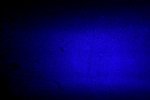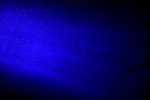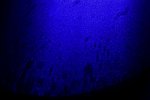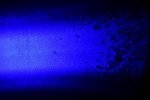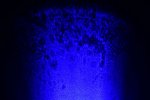- Joined
- Jul 4, 2008
- Messages
- 2,499
- Points
- 113
I just had an opportunity to inspect and benchmark/measure a laser that was purchased by a local Korean member. I met the member in central Seoul on Saturday. The member was kind enough to allow me to "borrow" it overnight. The build in question is an all copper laser, copper heatsink, and diode "host". The optics is a 405-G2 lens.
The owner of the laser had made mention that the optics seemed to be dirty and that he had tried to carefully clean it.
I decided to have a round on the G2 lens, and use and ultrasonic cleaner with 20% Ethanol sol. This usually gets any crap off the lens that would otherwise not be able to come off.
It was no use.
I noticed a very very slight improvement in the splash pattern after allow the lens to dry on an optical cloth.
I sent the picture of the splash pattern to Nikon optics division.
Their response was quite a surprise. MgF2 coated optics are apparently susceptible to Aspergillis mould. If the lenses are stored improperly, they can be a host for spores. When the mould starts to grow it will strip the coating off the lens creating dark oval circular patterns. since we are dealing with coherent light, these marks tend to show up much better.
The pattern to the Nikon representative looked exactly like a case of mould contamination.
So, for those people who live in humid climates take note. keep your lasers in a sealed box with desiccant. Aspergillis fungus is a coated lens worst enemy.
note the last picture is an old MgF2 coated vivatar lens. You can see the coating is gone on the sides of the lens.
Magnified you would be able to see the pattern match our G2 lens splash in pic2/3.
The owner of the laser had made mention that the optics seemed to be dirty and that he had tried to carefully clean it.
I decided to have a round on the G2 lens, and use and ultrasonic cleaner with 20% Ethanol sol. This usually gets any crap off the lens that would otherwise not be able to come off.
It was no use.
I noticed a very very slight improvement in the splash pattern after allow the lens to dry on an optical cloth.
I sent the picture of the splash pattern to Nikon optics division.
Their response was quite a surprise. MgF2 coated optics are apparently susceptible to Aspergillis mould. If the lenses are stored improperly, they can be a host for spores. When the mould starts to grow it will strip the coating off the lens creating dark oval circular patterns. since we are dealing with coherent light, these marks tend to show up much better.
The pattern to the Nikon representative looked exactly like a case of mould contamination.
So, for those people who live in humid climates take note. keep your lasers in a sealed box with desiccant. Aspergillis fungus is a coated lens worst enemy.
note the last picture is an old MgF2 coated vivatar lens. You can see the coating is gone on the sides of the lens.
Magnified you would be able to see the pattern match our G2 lens splash in pic2/3.
Last edited:





